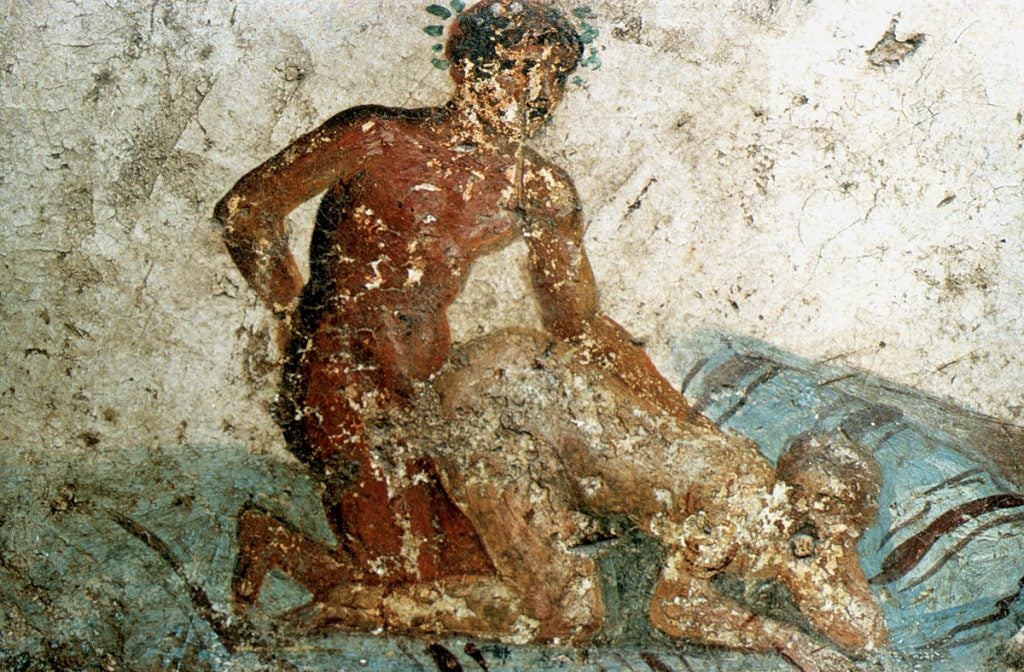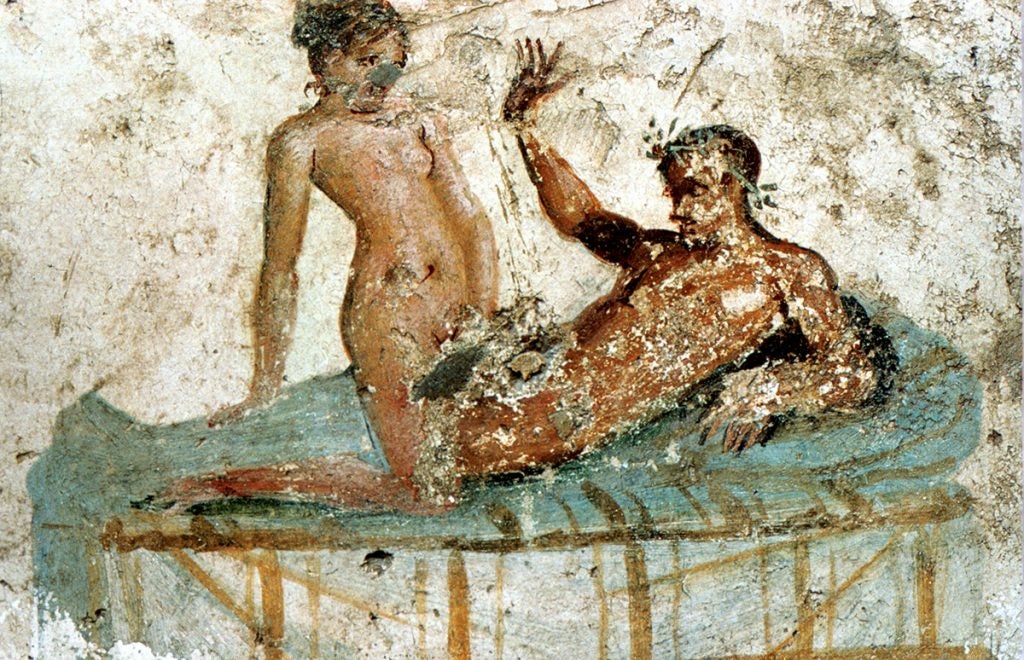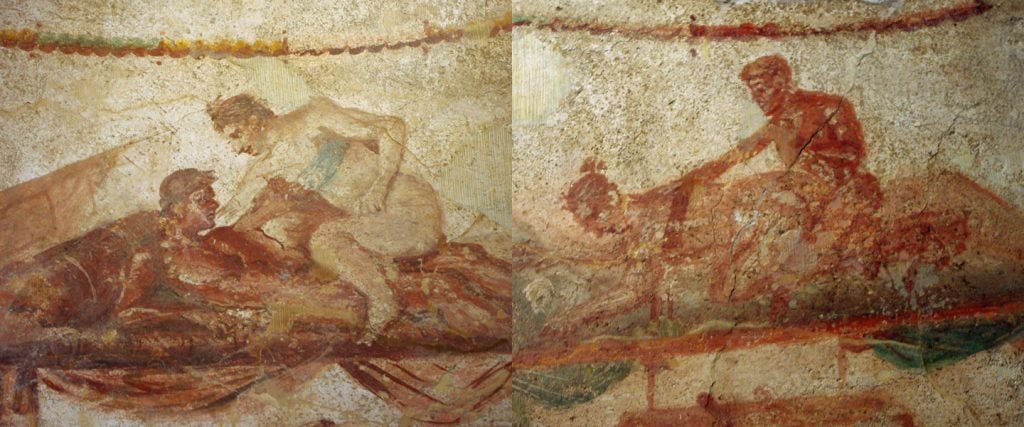It’s a widely accepted fact amongst historians that ancient Rome was a pretty horny place, at least until Emperor Theodosius I cracked down on “heretics” and made Christianity the default religion in 380 A.D.
Before then, guys fucked other guys frequently. Sodomy wasn’t criminalized, terms like “gay” didn’t exist and masculininity was glorified, so it was perfectly normal for bros to lust after other bros (though it was written into law that the “top” had to be of a higher social status than the “bottom”). Books about ancient Rome allude to salacious stories of riotous orgies and polygamous emperors, too. Nero, who reigned between 54 and 68 A.D., even married a male slave named Sporus, but only after castrating him and treating him like a woman.
Prostitution was a little trickier, though. Though sex was queer and rampant, the profession was seemingly stigmatized, and it was mainly “lower-class” women who worked in brothels (despite their jobs being a driving force of the ancient Roman economy). Much less is known about their male counterparts, though. Despite the bevy of evidence that some extremely kinky behavior took place in ancient Rome, the existence of male sex workers remains hugely under-discussed, and we’re just now learning about what life was like for them.
Interestingly, much of our intel comes from old graffiti. In her recently released book of sex work history, Harlots, Whores and Hackabouts, author Kate Lister analyzed a series of scrawls on the ruined walls of Pompeii’s oldest surviving brothel. Some were written by clients keen to brag about their lays — “here I fucked a girl” reads one — and others were straightforward price lists. Apparently, a blow job at the time would cost roughly the equivalent of $5 today. Some sex workers wrote jokes, too. In one, a woman refers to a regular client as “Mr. Garlic Farts.”

Clients left reviews of the sex workers they paid to fuck, too. Two names that recur frequently on those hallowed walls are Paris and Castrenis, both of whom were gay men. Barely anything is known about them, but the etchings on the wall repeatedly describe them as “beautiful.” What we do know is that they likely fucked male clients only. In an article that analyzes the brothel graffiti, classics professor Marguerite Johnson explains, “As freeborn women were not permitted to have intercourse with anyone but their husbands, the clients who accessed male sex workers were almost exclusively men.” As long as these guys followed the rules — clients weren’t allowed to bottom — they could fuck in peace, and leave behind crude drawings of their prostitute’s dicks afterwards.
Some of these carvings were more artistic. In her article, Johnson combs through various brothels and finds “murals… of fair-skinned women, naked, with stylized hair, in a variety of sexual positions with young, tanned, athletic men.” The beds are sometimes “ornate and festooned with decorative quilts.” It’s not clear in these murals who is the worker and who is the client, though — perhaps these lithe, sun-kissed studs are male sex workers, who secured illicit, clandestine fucks with rebellious, wealthy women.
One thing we can say for sure is that these male prostitutes didn’t exactly live glamorous lives. According to U.K.-based Chris Mowat, a 31-year-old ancient history researcher, there’s a “really important class distinction” when it comes to discussing the male sex workers of yore. Apparently, research refers to prostitutes as “human objects of male sexual gratification,” and Mowat says they were “mostly — but not always — enslaved people, either owned by those participating or hired out by pimps.” This was seemingly the case for both men and women. So, they may have been beautiful, but Paris and Castrenis were not privileged.
Mowat also underlines “blind spots” in scholarly work on these ancient workers, especially when their queerness — as we would view it today — is factored into the picture. The same can also be said of research on “gay” Roman history, which Mowat aims to fill with work written through a trans lens. As for gay orgies, Mowat explains: “We do know the ancient Romans were more open about sex acts, and there was a more normative attitude to men who have sex with men. We also have visual data backing up orgies, like the Warren Cup at the British Museum.” Mowat is referring to a $2.5 million silver chalice, decorated with the intertwined limbs of lusty young men.

The male sex workers of ancient Rome didn’t exactly live in peace prior to the enforcement of Christianity, but they were largely left alone as long as they registered themselves with the state authorities and applied for licenses to operate. Basically, as long as they were paying taxes, the more puritanical forces up high would turn a relatively blind eye.
This all changed in A.D. 380, and more extremely in A.D. 390, when the aforementioned Theodisius I “made forcing or selling men into prostitution a capital offense,” writes Lister. The crackdown put an end to ancient Rome’s gloriously horny underworld, and gay male sex workers were immediately targeted — according to Lister, angry mobs stormed male brothels, dragged the workers into the streets and burned them alive.
It’s an abrupt (and really violent) end to a fascinating, hidden history that sex historians are still trying to excavate. In the meantime, the drawings on the walls of ancient brothels are reassurance enough that, at least for a while, these guys lived, worked and fucked with abandon.

